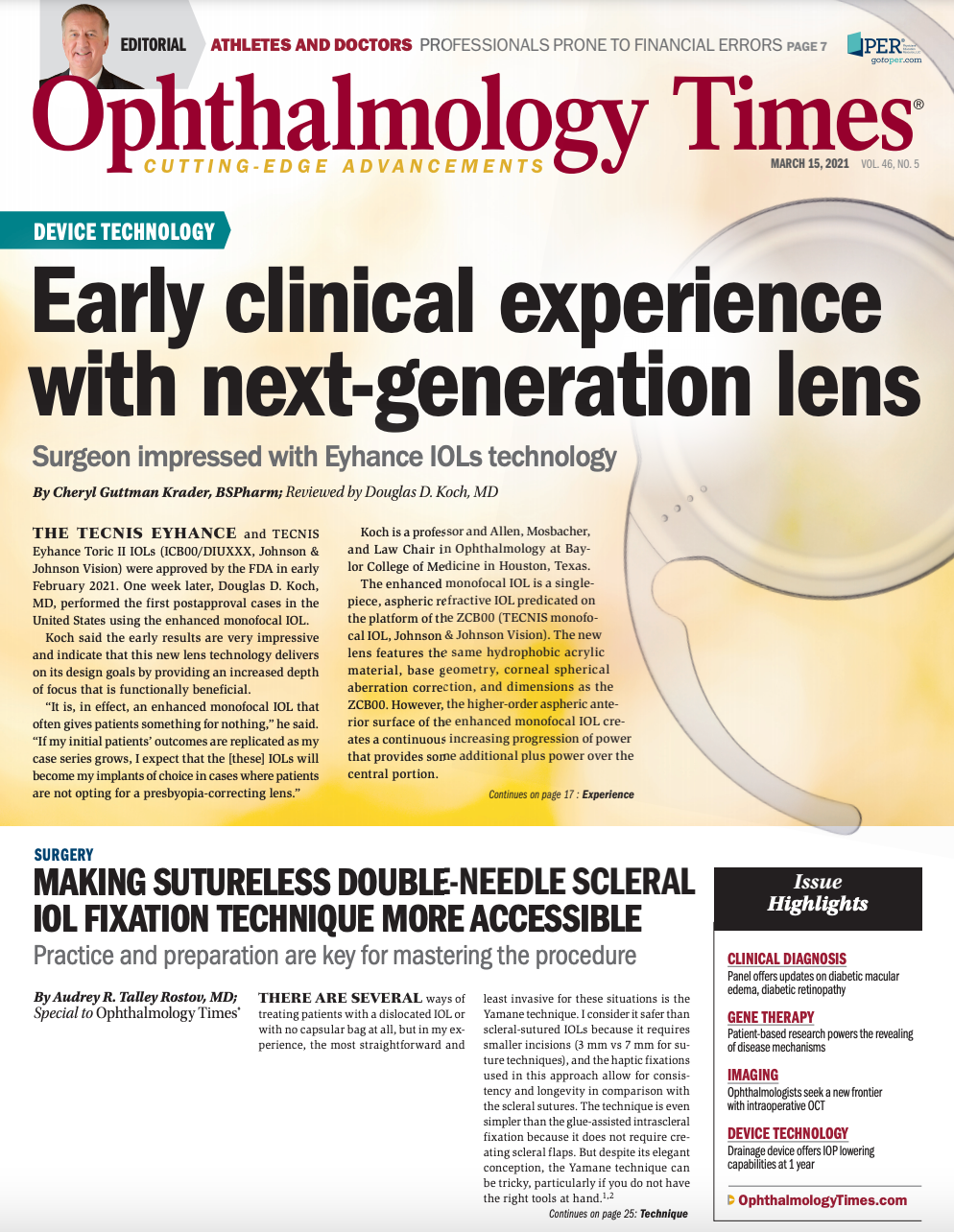Publication
Article
Digital Edition
Study finds sublingual troche, IV sedation are equivalent for cataract surgery
Author(s):
The method by which sedation is applied to keep patients relaxed and comfortable throughout cataract surgery can be tailored similar to that of anesthesia — surgical anesthesia is not a one size fits all endeavor.

Read the accompanying article to this: Comparable conscious sedation methods address individual patient needs
The amount of anesthesia used to keep a patient relaxed and comfortable throughout cataract surgery is tailored to each patient based on many factors, including age, medical history, and anxiety levels.
The method by which sedation is applied can be similarly tailored. Surgical anesthesia is not a one size fits all endeavor:
Some cataract patients feel comfortable following the traditional route where sedation includes intravenous (IV) versed or fentanyl or both, while others prefer a troche -- a lozenge that enables them to avoid both IV needles and opioids.
Related: Studies explore pharmacological approaches to cataract prophylaxis, treatment
Patients who have extensive medical histories such as those who have blood pressure problems, breathing problems that represent potential airway issues, and significant cardiac histories are better suited to IV sedation.
Sedation options
If patients prefer a less invasive sedation method or have ‘challenging’ veins, the troche approach can be an excellent option, for appropriate candidates.
Today, many patients appreciate the option of opioid-free sedation.
This is true for patients who have a history of opioid dependence, as well as others who simply prefer to avoid any potential problems that opioids could present.
As long as they are appropriate candidates for the troche, their preference can be taken into account.
We have made the option of troche sedation available to appropriate cataract patients for several years. In particular, we use the sublingual MKO MELT (ImprimisRx), a compounded formula comprised of 3 mg midazolam, 25 mg ketamine, and 2 mg ondansetron.
Post-operative surveys of patients consistently revealed that the troche patients were relaxed and comfortable throughout the process, and that they appreciated the absence of an IV needle stick.
Related: Challenges to topical drop adherence after cataract surgery
This positive feedback supported our ongoing use of MKO, but we wanted something more than anecdotal evidence and positive patient feedback to validate this option as its usecontinued to grow in the practice.
Study outcomes
My colleagues and I initiated a study comparing sublingual troche with traditional IV sedation, for maintaining comfort in patients undergoing cataract surgery.1
The results showed comparable experiences for both groups with equivalency in patient comfort among both women and men. We concluded that troche sedation provides an effective alternative anesthesia technique for cataract surgery.
Our findings were not surprising, as they reflected what we had seen for several years in practice.
We conducted the study at a surgery center using an after-only nonequivalent control group design. The cohort of 107 patients ranged from 55 to 85 years of age; 54 patients received IV sedation, and 53 received troche sedation.
Related: Good nutrition optimizes ocular surface in premium cataract patients
Four patients receiving IV sedation reported nausea during and after the procedure or pain during the procedure, whereas 3 patients receiving troche sedation reported dizziness after the procedure, and pain during the procedure.
Although the troche group spent less time in recovery than the IV group the difference was not significant.
Most patients received 2 MKO troches; of these 36 patients, 28 were 70 years of age or younger. The dosing of the troche sedation was determined by the age of the patients, medical history, and medications the patients were taking.
Five patients were dosed 1.5 MKO troches; and 12 were dosed 1 MKO troche.
Both the IV and troche groups stayed in recovery an average of 6 minutes, with the troche group experiencing only slightly less time than those in the IV group: 6.24 minutes vs 6.48 minutes.
The total time from administration of troche to incision for the patients receiving troche sedation varied from 20 to 73 minutes, with a mean of 41 minutes.
Related: Changing patient conversations around cataract surgery
Timing the medication for a surgical incision is challenging because delays in transportation to the operating room and initiation of the procedure can risk decreasing the medication efficacy.
Sedation techniques were equivalent and effective for those experiencing first or second cataract surgeries.
During the study, almost 60% of the patients had their first cataract surgery. Only 1 participant, who received IV sedation, reported pain during the first cataract surgery.
For second cataract surgeries, equal numbers of patients from the troche group and the IV sedation groups reported pain. Consistent with other research, more patients reported perceived pain with second cataract surgeries.2
Comparable alternative
The troche method has other advantages in addition to needle and opioid avoidance.
For instance, there is potential for decreased preoperative preparation time, as well as postoperative discharge time for troche sedation. This equates to a potential cost savings.
Related: Drop-free prophylaxis regimen before cataract surgery lowers treatment burden with caveats
At the time of our study, the cost of two troches was $30. The cost of IV sedation at the surgery center where the study took place, including a single IV insertion attempt and sedation with midazolam and fentanyl, totaled approximately $13.
However, the cost for IV sedation did not take into account the time for a trained individual to initiate catheter placement or the additional cost of multiple IV attempts.
The main takeaway is that MKO Melt is a comparable alternative to IV sedation and that anesthesia should be tailored to each patient.
Intravenous catheter placement preoperatively can be difficult and time-consuming, not to mention uncomfortable for the patient.
However, it’s important to remember that the sublingual troche is not appropriate for everyone and should be considered an alternative not a replacement
About the author
Jason C. Smith, DNP, CRNA
e: Jasonchadsmith@yahoo.com
Smith is a faculty member, Nurse Anesthesia Program, College of Applied Studies, Florida State University, Panama City, Florida, and a practicing CRNA, Jackson Anesthesia Associates, Marianna, Florida.
The author has no financial interest to report.
--
References
1. Smith JC, Hamilton BK, Stacey AV. Patient Comfort During Cataract Surgery: A Comparison of Troche and Intravenous Sedation.AANA Journal 2020; 88:429-435.
2. Akkaya S, Ozkurt YB, Aksoy S, et al. Differences in pain experience and cooperation between consecutive surgeries in patients undergoing phacoemulsification. Int Ophthalmol. 2017;37(3):545- 552.

Newsletter
Don’t miss out—get Ophthalmology Times updates on the latest clinical advancements and expert interviews, straight to your inbox.




